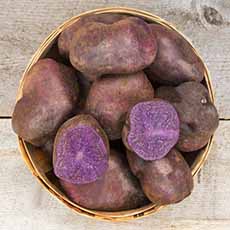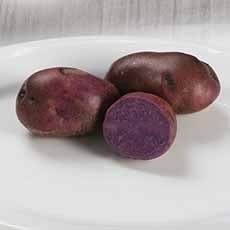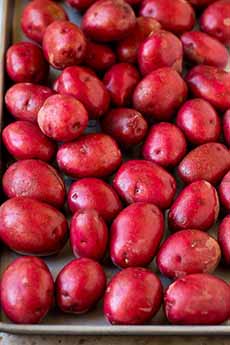Adirondack Blue Potatoes, Adirondack Red Potatoes: Potato Magic!
|
|
Are you a person who likes to change things up, innovate, generate delight, dazzle the kids? Well, here’s a game-changer for Thanksgiving (or any day of the year): blue mashed potatoes. They’re actually purple in color, but we’ll stick with the industry name: Adirondack blue potatoes. Beyond mashed, think blue baked potatoes. Roasted potatoes. Boiled potatoes. Potato salad. The large, oblong tubers taste like regular potatoes. And there’s also Adirondack Red! This beautiful red potato has red flesh, which turns a light shade of pink when boiled. As with Adirondack Blue, it’s excellent for baking, boiling, mashing, roasting, and potato salad. The red pigment is betacyanin, another powerful antioxidant that is red-violet and also colors beets, red cabbage, and many other plants. It’s a much more common pigment in the plant kingdom than the blue anthocyanidin and anthocyanin*. Thanks go to Walter de Jong, Ken Paddock, and Robert Plaisted, potato-genetics scientists at the Cornell University School of Integrated Plant Science Plant Breeding & Genetics Section. They released Adirondack Blue in 2003 after many years of development and testing. (The potatoes are non-GMO). They focus on the genetic improvement of the potato, both by conventional and molecular genetic means. (Note that this does NOT mean genetically modified organisms. These potatoes are Non-GMO.) Shortly after Adirondack Blue, they released Adirondack Red, Keuka Gold, and Yukon Gem, all huge successes grown in the Northeast by specialty potato farmers. Adirondack and Keuka are both places in the Northeast. The Adirondack Mountains are a range in northeastern Upstate New York, Keuka is one of the major Finger Lakes in New York State. *Anthocyanins, powerful antioxidants that can lower risks of heart and neurological diseases. But don’t use that as an opportunity to over-indulge! Anthocyanidin and anthocyanin are two types of red-blue plant flavonoids, mostly found in flowers and fruits of higher plants. The main difference between them is that anthocyanin is a water-soluble vacuolar pigment, whereas anthocyanidin is the sugar-free counterpart of anthocyanin [source]. Here’s more about antioxidants. |
|
|
|
||






